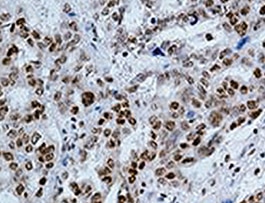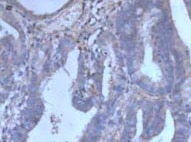Mouse Artemin Antibody Summary
Ala112-Gly224
Accession # Q9Z0L2.1
Applications
under non-reducing conditions only
Please Note: Optimal dilutions should be determined by each laboratory for each application. General Protocols are available in the Technical Information section on our website.
Scientific Data
 View Larger
View Larger
Artemin in Human tonsil. Artemin was detected in immersion fixed paraffin-embedded sections of human tonsil using Rat Anti-Mouse Artemin Monoclonal Antibody (Catalog # MAB10851) at 3 µg/mL for 1 hour at room temperature followed by incubation with the Anti-Rabbit IgG VisUCyte™ HRP Polymer Antibody (VC003). Before incubation with the primary antibody, tissue was subjected to heat-induced epitope retrieval using Antigen Retrieval Reagent-Basic (CTS013). Tissue was stained using DAB (brown) and counterstained with hematoxylin (blue). Specific staining was localized to lymphocytes in germinal centers. Staining was performed using our protocol for IHC Staining with VisUCyte HRP Polymer Detection Reagents.
Preparation and Storage
- 12 months from date of receipt, -20 to -70 °C as supplied.
- 1 month, 2 to 8 °C under sterile conditions after reconstitution.
- 6 months, -20 to -70 °C under sterile conditions after reconstitution.
Background: Artemin
Artemin is a member of the Glia Cell-Derived Neurotrophic factor (GDNF) family ligands, which include GDNF, Persephin, Artemin, and Neurturin. GDNF family ligands are distant members of the Transforming Growth Factor beta (TGF-beta ) superfamily (1‑4). Similar to other TGF-beta family proteins, Artemin is synthesized as a large precursor protein that is cleaved at the dibasic cleavage site (RXXR) to release the carboxy-terminal domain. The carboxy-terminal domain of Artemin contains the characteristic seven conserved cysteine residues necessary for the formation of the cysteine-knot and the single interchain disulfide bond. Biologically active Artemin is a disulfide-linked homodimer of the carboxy-terminal 113 amino acid residues. Mature mouse Artemin shares 88.5% amino acid sequence similarity with human Artemin. Mature Artemin also shares approximately 40% amino acid sequence identity with the other three members of the GDNF family ligands (5). Bioactivities of all GDNF family ligands are mediated through a receptor complex composed of a high affinity ligand binding component (GFR alpha 1‑GFR alpha 4) and a common signaling component, cRET (receptor tyrosine kinase) (5‑8). Artemin prefers to bind to GFR alpha 3 and activites the GFR alpha 3‑RET. However, in the presence of RET, it can bind to GFR alpha 1 as well (4, 5, 9). Artemin has been shown to promote the survival and growth of various peripheral and central neurons, including sympathetic and dopaminergic neurons. It may also play an important role in the development of sympathetic neurons and several organs (5, 10, 11).
- Lin, L-F.H. et al. (1993) Science 260:1130.
- Milbrandt, J. et al. (1998) Neuron 20:245.
- Kotzbauer, P.T. et al. (1996) Nature 384:467.
- Baloh, R.H. et al. (1998) Neuron 21:1291.
- Takahashi, M. (2001) Cytokine and Growth Factor Reviews 12:361.
- Baloh, R.H. et al. (1997) Neuron 18:793.
- Jing, S. et al. (1996) Cell 85:1113.
- Jing, S. et al. (1997) J Biol Chem 272:33111.
- Nishino, J. et al. (1999) Neuron 23:725.
- Enomoto, H. et al. (2001) Development 128:3963.
- Andres, R. et al. (2001) Development 128:3685.
Product Datasheets
Citations for Mouse Artemin Antibody
R&D Systems personnel manually curate a database that contains references using R&D Systems products. The data collected includes not only links to publications in PubMed, but also provides information about sample types, species, and experimental conditions.
5
Citations: Showing 1 - 5
Filter your results:
Filter by:
-
Investigating the Role of Artemin and Its Cognate Receptor, GFR alpha 3, in Osteoarthritis Pain
Authors: Laura Minnema, Ankita Gupta, Santosh K. Mishra, B. Duncan X. Lascelles
Frontiers in Neuroscience
-
Aryl Hydrocarbon Receptor Directly Regulates Artemin Gene Expression
Authors: Tomohiro Edamitsu, Keiko Taguchi, Eri H. Kobayashi, Ryuhei Okuyama, Masayuki Yamamoto
Molecular and Cellular Biology
-
The aryl hydrocarbon receptor AhR links atopic dermatitis and air pollution via induction of the neurotrophic factor artemin
Nat. Immunol., 2016-11-21;0(0):.
Species: Mouse
Sample Types: In Vivo
Applications: Neutralization -
The neurotrophic factor receptor RET drives haematopoietic stem cell survival and function.
Authors: Fonseca-Pereira D, Arroz-Madeira S, Rodrigues-Campos M, Barbosa I, Domingues R, Bento T, Almeida A, Ribeiro H, Potocnik A, Enomoto H, Veiga-Fernandes H
Nature, 2014-07-27;514(7520):98-101.
Species: Mouse
Sample Types: Whole Cells
Applications: ICC -
Artemin-GFRalpha3 interactions partially contribute to acute inflammatory hypersensitivity.
Authors: Thornton P, Hatcher J, Robinson I, Sargent B, Franzen B, Martino G, Kitching L, Glover C, Anderson D, Forsmo-Bruce H, Low C, Cusdin F, Dosanjh B, Williams W, Steffen A, Thompson S, Eklund M, Lloyd C, Chessell I, Hughes J
Neurosci Lett, 2013-04-19;545(0):23-8.
Species: Mouse
Sample Types: In Vivo
Applications: In Vivo
FAQs
No product specific FAQs exist for this product, however you may
View all Antibody FAQsReviews for Mouse Artemin Antibody
Average Rating: 5 (Based on 2 Reviews)
Have you used Mouse Artemin Antibody?
Submit a review and receive an Amazon gift card.
$25/€18/£15/$25CAN/¥75 Yuan/¥2500 Yen for a review with an image
$10/€7/£6/$10 CAD/¥70 Yuan/¥1110 Yen for a review without an image
Filter by:



